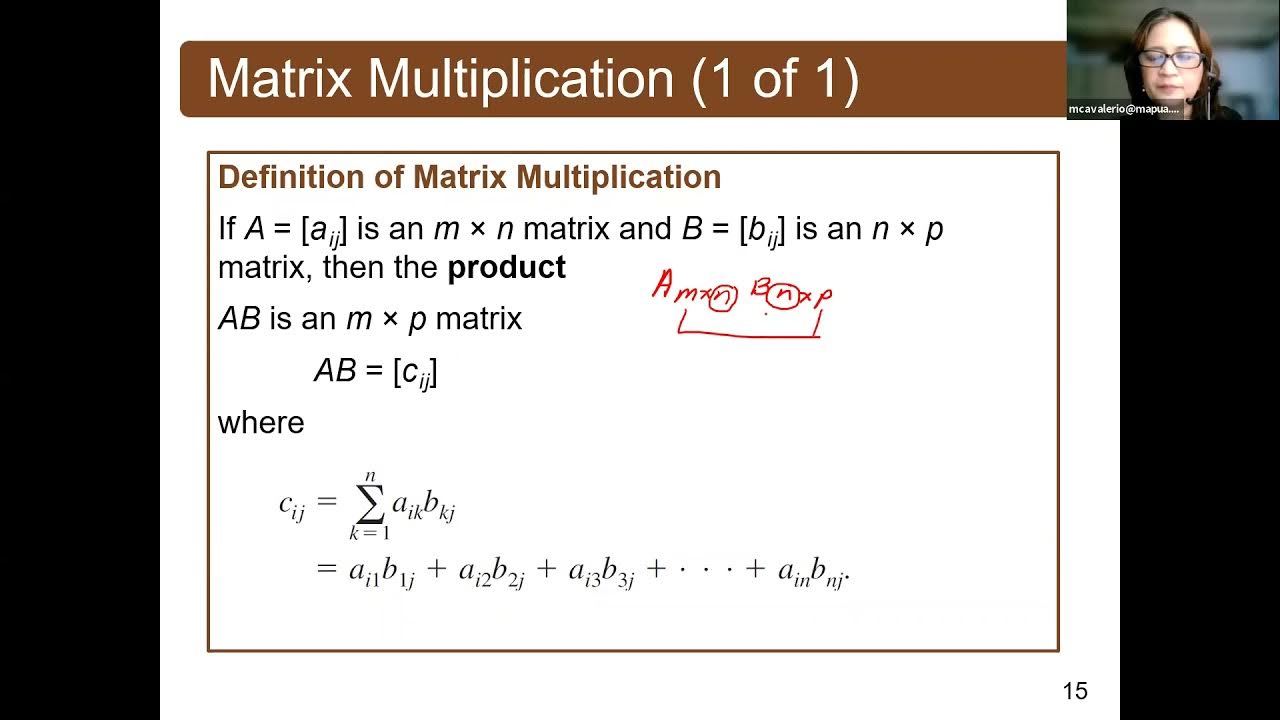Adding and Subtracting Matrices
Summary
TLDRThis lesson teaches the fundamentals of matrix addition and subtraction. It begins with a simple example of adding two 2x2 matrices, A and B, by summing corresponding elements to form a new matrix. The process is then applied to a subtraction example with matrices C and D. The lesson escalates in complexity with a 3x3 matrix addition, demonstrating the method for larger matrices. Finally, a subtraction example with matrices E and F concludes the lesson, illustrating the process with step-by-step calculations. The script emphasizes the necessity of matrices having the same order for these operations.
Takeaways
- 📚 The lesson focuses on adding and subtracting matrices, which requires understanding of basic arithmetic operations.
- 🔍 To add or subtract matrices, they must be of the same order, meaning they have the same number of rows and columns.
- 📐 The process involves adding or subtracting corresponding elements in the matrices, starting from the top left and moving right and down.
- 🧩 The first example demonstrates adding two 2x2 matrices, resulting in a new matrix with elements obtained by adding corresponding elements of the original matrices.
- ➕ The sum of matrix A and B is a new matrix with elements 12, -9, 10, and -1, obtained by adding corresponding elements of A and B.
- 📉 The second example involves subtracting matrix D from matrix C, resulting in a new matrix with elements obtained by subtracting corresponding elements.
- ➖ The difference between matrix C and D is a new matrix with elements 1, -1, 3, and 0, obtained by subtracting corresponding elements.
- 📈 The third example increases the complexity by using 3x3 matrices, requiring the addition of more elements in each row and column.
- 🔢 The sum of the 3x3 matrices A and B is a new matrix with elements 7, 11, 2, 2, 14, 6, -4, -4, and -6.
- 🔄 The final example demonstrates the subtraction of two 3x3 matrices, E and F, resulting in a new matrix with elements obtained by subtracting corresponding elements.
- 📊 The difference between matrix E and F is a new matrix with elements -5, 2, -3, -1, 2, and 7, illustrating the subtraction process.
Q & A
What is the process of adding two matrices?
-To add two matrices, you add the corresponding elements in the same position in each matrix. Both matrices must have the same order, meaning the same number of rows and columns.
What is the sum of matrix A and matrix B, given matrix A has the elements 3, -4, 8, 5 and matrix B has the elements 9, 2, -5, -6?
-The sum of matrix A and matrix B is a new matrix with the elements 12, -9, 10, -1, obtained by adding the corresponding elements of A and B.
What is the process of subtracting one matrix from another?
-To subtract one matrix from another, you subtract the corresponding elements in the same position in each matrix. Both matrices must have the same order.
What is the difference between matrix C and matrix D, given matrix C has the elements 7, -2, 8, 3 and matrix D has the elements 6, -1, 5, 3?
-The difference between matrix C and matrix D is a new matrix with the elements 1, -1, 3, 0, obtained by subtracting the corresponding elements of D from C.
Why do matrices need to have the same order for addition or subtraction?
-Matrices need to have the same order for addition or subtraction because the operation involves corresponding elements from each matrix, which is only possible if the matrices have the same dimensions.
What happens when you add or subtract a three by three matrix?
-When adding or subtracting a three by three matrix, you perform the operation element-wise across the rows and columns, ensuring that the matrices have the same dimensions.
What is the sum of a three by three matrix A with elements 3, 8, -5, 4, 6, 2, -7, 1, 3 and matrix B with elements 4, 3, 7, -2, 8, 4, 3, -5, -9?
-The sum of matrix A and matrix B is a new three by three matrix with elements 7, 11, 2, 2, 14, 6, -4, -4, -6.
How do you calculate the difference between matrix E and matrix F, given their elements?
-To calculate the difference between matrix E and matrix F, you subtract the corresponding elements of matrix F from matrix E.
What is the difference between matrix E with elements 2, 5, -9, 4, -6, 3 and matrix F with elements 7, 3, -6, 5, -8, -4?
-The difference between matrix E and matrix F is a new matrix with elements -5, 2, -3, -1, 2, 7.
Why is it important to pay attention to the signs when performing matrix operations?
-It is important to pay attention to the signs when performing matrix operations because incorrect handling of signs can lead to wrong results, especially with negative numbers.
Can you perform matrix addition or subtraction with matrices of different sizes?
-No, you cannot perform matrix addition or subtraction with matrices of different sizes because the operation requires corresponding elements to be added or subtracted, which is not possible with matrices of differing dimensions.
Outlines

Cette section est réservée aux utilisateurs payants. Améliorez votre compte pour accéder à cette section.
Améliorer maintenantMindmap

Cette section est réservée aux utilisateurs payants. Améliorez votre compte pour accéder à cette section.
Améliorer maintenantKeywords

Cette section est réservée aux utilisateurs payants. Améliorez votre compte pour accéder à cette section.
Améliorer maintenantHighlights

Cette section est réservée aux utilisateurs payants. Améliorez votre compte pour accéder à cette section.
Améliorer maintenantTranscripts

Cette section est réservée aux utilisateurs payants. Améliorez votre compte pour accéder à cette section.
Améliorer maintenant5.0 / 5 (0 votes)






